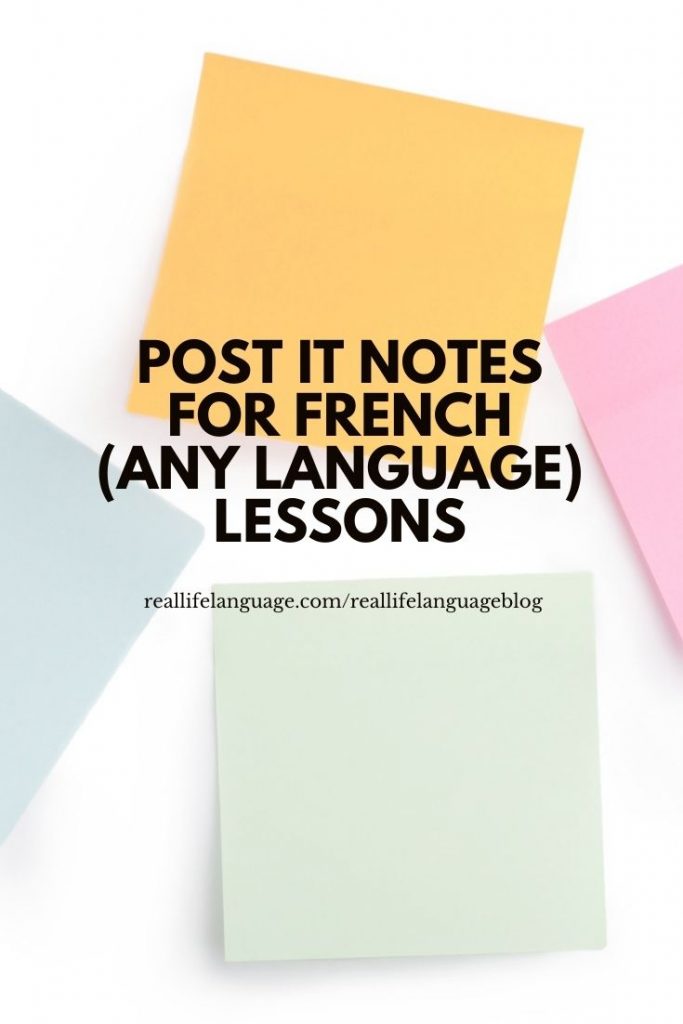Post it Notes for French (or any language) lessons
Post it notes are one of my favorite resources for French (or any language) lesson. They are flexible, adaptable and can be used in so many ways.
Check out some of my favorite ways to use Post it notes in my language classes:
Label vocabulary: Have students label vocabulary in your classroom, around your school, their clothing, parts of the body, realia- anything. The possibilities are endless! Great lesson for beginning French writing.
Categories: Have students write themed vocabulary during a unit of study on Post Its. They stick them to a board and have them to refer to throughout the unit. Helpful visual for any language unit of study.
Pinterest: Have students research any aspect of the target culture and bring in photos. They should use a Post It note to write a caption. Hang up the boards. Students write their comments on Post It notes and add to the thread.
Test Review: Have students write questions from any chapter or unit of study you are working on. Organize them by theme on a large piece of paper or the board. Get the class together and review the content on your assessment.
Jeopardy: Have the students write answers from the content you are studying on Post It notes. Organize them on a board. Students must ask questions.
Quiz/Challenge Board: Have students write questions on any given topic. The class divides up into teams and plays.
Reading: As foreign language teachers, we give students reading selections that have a great deal of unknown vocabulary. Have students read in pairs, making notes on Post Its on meaning, context, vocabulary, etc. in the margins. This is an active way to help them negotiate meaning.
Interactive Reading: A variation of this is to have students write a question or two on certain sections of text, as well as the answer. They then ask and answer the questions when the class takes turns reading out loud. This is another active reading lesson that requires a great deal of engagement.
Speech Feedback: During oral presentations, have the audience write feedback for the presenter on Post It notes. We usually set some ground rules before doing this so that all understand what constructive criticism is and what it is not. At the end, the audience puts their notes on a piece of paper and the presenter walks away with feedback. The feedback can be themed (i.e. use of a structure, a question, a compliment, etc.).
Mini Writer’s Workshop: Again, the students share something that they have written. Feedback (normally what is great and what can make it even better) is shared on Post its. The author walks away with a paper full of feedback.
Ask a Question: Have the students write questions they need the answer to on Post its. They pass the notes around looking for people with the answer. After the notes have been passed around, the class convenes and discusses all the questions and answers.
Illustrate Reading/Label: This is great for tackling difficult reading. Give students small Post its to label unknown vocabulary in the text and larger ones to illustrate sections of the reading. Students can use the illustrations to retell the story to the class.
Jigsaw/Summary: Perfect for a more advanced French lesson. Students can be assigned a section of a text. They are responsible for mastery of that section. Give them small notes to label vocabulary and large notes to summarize, or put in bullet points, their section of the text. As a group, put the selection together. The Post It notes can be placed in order on a paper and copied. The students then must retell the content in their own words.
Park a Question: They don’t know something in the lesson? Have a section in your room where they can ask and park a question they don’t want to ask the class.
Describing Paintings: If you have paintings in your room from the target culture, students can write a sentence or two-length description and place it on the painting. The students can practice reading and descriptions.
Storyboard: This works well for narration. The students can take four or five (or however many you want) medium-sized Post iIs to craft a short story. They can write bullet points and drawings on the notes. These notes then can be used to narrate a story.
Essay Organizer: Similar to Storyboard, this activity helps students organize an essay using Post its. One example is the classic five-paragraph essay. Students should make bullet points on one for the introduction, one for each of the three paragraphs they will write and one for the conclusion. Organize the notes and write the essay.
Organize a Letter: Similar to Essay Organizer, have students bullet point what will go in different parts of a letter. Organize it and write the letter. Essential lesson for French, Spanish, German (or any) language!
Rubrics: Giant Post its can be used to create rubrics with students on an assignment. Keep the Post it up as they work as well as type out a copy for them to take home.
Looking for more ideas for your language classes? Get your free 5 Weeks of Low and No Prep Fun guide here.
